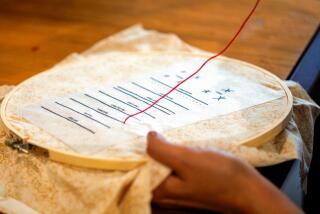Heart & Crafts
- Share via
LUDLOW, VT. — Paradise is a subjective thing: a secluded tropical beach. A bottomless shopping spree at Barneys. Eating all the chocolate you want and never gaining weight.
Mine is being able to work on craft projects for days without major disruptions.
Anyone who sews, crochets, knits, weaves, wood works, etc., understands this. I love my husband, I love my job and I love my cats, but they leave precious little time for much else.
So when I saw the ad in Threads (a sewing magazine) last spring for the Fletcher Farm School for the Arts and Crafts in Ludlow, Vt., I immediately called for a catalog. In its pages I discovered paradise--summer classes in everything from floral design to woodcarving to rug hooking to tole painting, all held in a converted farmhouse surrounded by verdant fields and hills. I knew that Vermont was also a craftsperson’s dream, with cottage industries in weaving, glass blowing and pewter scattered throughout the state.
Perusing the Fletcher catalog, I zeroed in on quilting, finding a five-day beginning class in early July. Intensive instruction was exactly what I wanted. For years I longed to learn how to quilt, but the few classes I had taken in Los Angeles always followed an exhausting day at work. So far I only knew quilting as a frustrating, tedious craft, and yards of fabric sat gathering dust in my closet. I still wanted to try, but under better conditions.
Space was still available when I called, and the winter registrar promised to mail me a class supply list as well as information on accommodations and what personal items I’d need. The class was $175, and for an additional $50 a day I’d get three meals and a single room in a dorm-like facility, sharing a toilet with my next-door neighbor and showering down the hall--rustic was the word that came to mind, but that was fine with me.
There was only one little problem--I’d have to haul my extraordinarily heavy Bernina sewing machine 3,000 miles, along with fabric and other supplies, plus clothes. Although I found a travel case for the Bernina and it fit under the airplane seat, schlepping it was not a pleasant experience. Apparently airport security hadn’t seen many on the X-ray machine; they’d invariably furrow their brow and say, “What is this?” I quickly learned to yell, “It’s a sewing machine!” as it lumbered down the conveyor belt.
I arrived in Burlington a day before orientation, picked up a rental car and checked into a motel. It would take several hours to drive south to Ludlow and after a long flight, I needed a night of rest.
After tooling through the bucolic wonderland that is Vermont--farmhouses, sweet small towns and charming Victorian buildings--I arrived in Ludlow in the late afternoon and had no trouble finding Fletcher, which is on the main road past the town’s center. I checked in and found my room in a building called “The Roost.” It was indeed rustic, but not uncomfortable, with a twin bed, desk, sink, chair, fan and open closet. I felt like a student again.
That evening students and instructors gathered for orientation. It looked like a small group, but I discovered later that the school filled up more toward the end of summer. Then we regrouped into our classes, and our instructor, Nola Forbes, led us to what would be our classroom for the next five days: a converted barn, outfitted with long tables for cutting and sewing.
I instantly liked Nola. A Vermont schoolteacher with years of quilting experience and associations with various guilds, she made it clear we were in for a lot of work. Yet she was eager to have us soak up as much knowledge as we could in five days. She explained that we’d start out with a basic nine-patch block, then move onto more advanced blocks and techniques that included hand applique and sewing curves. By the end we’d have six different blocks ready to be made into a quilt.
We’d begin at 9 a.m., break at noon for lunch, come back at 1 p.m. and work till 5, then break for dinner. Every night there was an open studio from 7 to 9 p.m., where we could work on that day’s project.
I was one of only four students in the quilting course; the others were Sandra, a 40ish woman; Anita, an older woman originally from England; and Alice, a grandmother. They were all from nearby states and had driven to the school. Sandra was the veteran of the group, having taken classes at Fletcher for years. She said coming here was her annual birthday gift to herself.
*
The first day of class flew by as Nola looked over our fabrics and helped us choose appropriate colors and patterns. After I’d completed a nine-patch, the most basic and easiest block, there was a great sense of accomplishment--the quilting equivalent of climbing Mt. Everest. We praised each other’s work and proudly hung them on the wall.
Nola provided unlimited patience and care in solving our most perplexing problems. Instead of simply saying, “Do it this way,” she explained why she used a certain technique. She also had a wealth of knowledge about the history of quilting. I learned more from her in one day than I had in all those other courses I took.
The five of us bonded quickly, chatting about our families, travels and other interests. Anita, an experienced weaver, explained that growing up in England, every girl was taught handwork. Sandra was an avid gardener, and Alice told us what it was like to be involved with raising her granddaughter. We didn’t even mention our real jobs until the last day of class.
During breaks we’d wander into other classes and check out the rug hookers and braiders, the primitive landscape painters, and the teen woodcarving workshop. (Minors are day students only and are not allowed to board at the school.) Always beckoning was the school’s on-campus craft shop, which offered beautiful items handmade by students and faculty.
Meals were served buffet-style and consisted of basic but hearty fare. Breakfast might be eggs, toast and fruit; lunch, BLTs, salad and dessert; dinner, barbecued chicken, vegetables and potatoes. The cook was happy to accommodate special requests such as vegetarian plates, so no one ever went hungry.
By the third day I was completely enjoying quilting, even when I had to rip out seam after seam after making a monumental mistake. I’d wrap up about 9, exhausted but happy, and walk back to my room through pirouetting fireflies.
I was a bit sad, though, that I didn’t have more time to explore the area. That is, until Sandra instigated a couple of impromptu daytime field trips. One day we all packed into her fire-engine-red sports utility vehicle and rode into the center of Ludlow, which is a popular ski resort. We wandered through antique shops (where prices weren’t outrageous) and clothing and gift boutiques, and even found a fabric store that catered to quilters. On another outing we drove to nearby Chester, famous for its beautifully restored Victorian houses.
On the last day of class, Nola urged me to stop at the Shelburne Museum on my way back to Burlington. The museum, which houses 37 early New England buildings on 45 acres, has an incredible, extensive quilt collection. I was able to spend a couple of hours there, mostly drooling over the phenomenal antique quilts and other examples of needlework on display.
I would love to go back to Fletcher next summer. If you’re considering taking a class or seminar in a craft, here are a few pointers:
* There are craft schools, workshops and seminars all around the country throughout the year. One way to find them is through ads in specialty craft magazines, such as Threads, Teddy Bear and Friends, and The Crafts Report. Places such as Coupeville Arts Center in Coupeville, Wash.; the Hill Country Arts Foundations in Ingram, Texas; and summer workshops at the Oregon School of Art and Craft in Portland are just a sampling of what’s available. Call the school for a brochure, and don’t be shy about asking questions. How old is the school? What accommodations are available? Not all offer on-campus housing. What skill levels are required for the various classes? Who are the instructors? How many students are in a class? What is the school’s refund policy? What will the weather be like?
Although I was able to arrive with all the materials my class required (I ended up buying some in Vermont that I couldn’t take on the plane, such as a large cutting mat), I didn’t use all of them. What I should have done is called the instructor to find out what I absolutely needed. For example, since we didn’t finish the quilt, I didn’t have to bring bulky batting.
* If you’re planning on exploring the area where your workshop is, I suggest doing it after the class. You’ll probably pick up information on great museums, shops and attractions from students and teachers familiar with the region. I heard about some wonderful places nearby such as Bennington (home of pottery) but kicked myself because I didn’t allow a couple of extra days. I could have spent two days at the Shelburne Museum alone.
* If you’re flying and are carrying odd items (such as a sewing machine), allow extra time to go through airport security. On every leg of my trip I asked to pre-board.
* Be prepared to work. If you want a totally relaxing vacation, this isn’t it. But by accepting the challenge of learning new skills, it will be one trip you won’t forget.
Stein writes for The Times’ Life & Style section.
(BEGIN TEXT OF INFOBOX / INFOGRAPHIC)
GUIDEBOOK
Vermont Basics
Getting there: Air fare from L.A. to Burlington, Vt., on US Airways or United is about $560 round trip. Or fly to Albany, N.Y., on those airlines or American for about $550 round trip. Ludlow is a few hours south by car from Burlington (there are rental car agencies at the airport) and northeast from Albany; ideally allow a day for the drive in.
Fletcher Farm School: Open summers only, late June through late August. Offered are five-day classes (most were $175 in 1997) and two-day workshops (most $85). Room and board, $50 per day. 1998 prices will be $5-$10 higher. Fletcher’s 1998 catalog will be available in March; call (802) 228-8770, or write Fletcher Farm School for the Arts and Crafts, 611 Route 103 South, Ludlow, VT 05149.
Where to stay: A sampling of other lodgings in Ludlow: The Happy Trails Motel, 321 Route 103 South, Ludlow; telephone (802) 228-8888, from $59 to $79 a night. The Jewel Brook Inn, 82 Andover St., Ludlow, on Route 100 South; tel. (802) 228-8926; $70 a night. The Castle, Route 103, Cavendish, Proctorsville, VT 05153; tel. (802) 228-7222; $90 to $140 a night with breakfast.
Where to eat: Michael’s (basic seafood and steak menu), south of Ludlow village on Route 103; tel. (802) 228-5622. Entrees at this and other spots mentioned run $8-$11. The Pot Belly Pub (your basic pub fare), 130 Main St., Ludlow; tel. (802) 228-8989. Cappuccino’s Cafe, Italian food and bakery, 41 Depot St., Ludlow; tel. (802) 228-7566.
For more information: Vermont Travel Division, 134 State St., Montpelier, VT 05602; tel. (800) VERMONT.


